Bedding
Published June 15, 2022
13 minMattress Pad vs Mattress Topper: What Is the Difference?
A mattress accessory can be the ultimate way to customize your old mattress and make it more comfortable for you to skip tossing and turning all night. The decision boils down to choosing between a ma

Table of contents
Mattress Pad Vs Mattress Topper: Key Differences What is a Mattress Pad? What is a Mattress Topper?Do I Need Both Mattress Pad & Topper? Conclusion Frequently Asked Questions
A mattress accessory can be the ultimate way to customize your old mattress and make it more comfortable for you to skip tossing and turning all night. The decision boils down to choosing between a mattress pad and a mattress topper. A mattress pad adds a thin layer of comfort and enhanced protection to your old mattress. In contrast, mattress toppers offer a much thicker layer to yield extra support and super comfort to even the most uncomfortable mattresses. Many get confused about mattress pad vs. mattress topper. Which one to choose, or should you use both? Here, we inform you all about mattress topper vs. mattress pad to help you nail the right accessory for deep, comfortable sleep. Stay tuned!
Deciding between a mattress pad or mattress topper is primarily a personal choice. It largely depends on your budget and the extent of altered feel you want to lend to your old mattress. A mattress pad offers more protection to the mattress at a lower cost but slightly alters its feel, cushion, softness, and support. In contrast, mattress toppers can significantly change the feel of the old mattress and lend protection but with a higher price tag. However, it is an excellent and cost-effective alternative to buying a new mattress.
Mattress Pad Vs Mattress Topper: Key Differences
Both mattress pad and mattress topper provide an extra protective layer to cushion your bed and alter its feel. But a significant difference between mattress pad and mattress topper is their thickness, impacting their performance and other specifications. Let’s compare to see how they stack up against each other.| Features | Mattress Pad | Mattress Topper |
|---|---|---|
| Thickness | Usually of one inch and never more than two inches | A minimum of two to four inches of thickness |
| Feel | Does not change the feel of the old mattress significantly | Changes the feel of the old mattress significantly |
| Purpose | Enhances the softness and protection slightly | mattress with better protection |
| Protection From Wear & Tear | Light protection comparatively | Enhanced and better protection due to its thickness |
| Protection From Spills | Protects mattress by soaking spills | Due to the soaking of spills, it can protect the old mattress but gets destroyed as primarily unwashable |
| Support | Slight support | More robust support due to its thickness |
| Temperature-Regulating Properties | Absent | Is present if the material used is wool or a few breathable foams |
| Maintenance | Easy to machine-wash and maintain | Heavy and cumbersome to wash and maintain |
| Durability | 2-5 years depending on usage | More durable than a mattress pad, depending on usage |
| Cost | Usually less than $100, but maximum pricing can be around $300, depending on the material used | Price can range from $200 to $400 depending on the material used |
What is a Mattress Pad?
A mattress pad is a thin padded or quilted layer of one inch or less placed on the top of the mattress to make it softer and more comfortable. It is generally available as fitted sheets or with elastic straps so that it anchors well to the mattress and does not shift while you sleep on it. These pads are crafted from many materials like cotton, down, rayon, polyester, etc. The different mattress pad materials decide the specific pad’s benefit, comfort, and other features.You should consider buying a mattress pad if:- You want to add softness and enhanced comfort to your old, firm mattress.
- You desire a budget-friendly solution to upgrade your mattress instead of purchasing a new one.
- You want to protect your mattress against general wear and tear, spills, urine accidents, stains, etc.
Mattress Pad Types
Mattress pads are available in several types to cater to different bed-related issues. A few common types are:- Latex Mattress Pad
- Cotton Mattress Pad
- Synthetic fiber Mattress Pad
- Down Mattress Pad
- Memory Foam Mattress Pad
- Feather Mattress Pad
Benefits of Mattress Pads
A mattress pad offers you several benefits.- Because it provides a protective layer to your mattress, it keeps its integrity intact and increases the longevity and durability of the mattress. It not only protects the mattress against liquid spills, sweat, urine, and general wear and tear but also from infestations like dust mites, bed bugs, and similar critters.
- These are pocket-friendly and inexpensive, as most are below $100.
- They are easy to transport, move around, wash or maundered, or attach and detach to the mattress.
- They remain stable due to how it clings to the mattress and do not cause inconvenience or discomfort as you sleep on them.
- If your mattress protector makes noises, the mattress is a perfect solution to reduce unwanted noise.
- Mattress pads are excellent for minimizing allergy flare-ups if crafted from hypoallergenic materials.
- Suppose your mattress is worn out, too firm , or has other problems. In that case, the extra one to two inches of the pads works terrific in adding some softness, plushness, support, and comfort to the old mattress. This way, you need not invest in a new mattress.
Drawbacks of Mattress Pads
Let’s now walk through the flip side of mattress pads.- While the brand and type can impact the experience, mattress pads are generally flimsy and vulnerable to easy damage.
- Because the mattress pads are just one to two inches thick, they do not alter the support, comfort, or plushness to a significant level, especially when comparing mattress topper vs pad.
- Mattress pads can be noisy if made of waterproof materials.
- If not waterproof, the mattress pads tend to soak all dirt, spills, etc. They barely can repel, so they get damaged and need frequent replacement.
What is a Mattress Topper?
A mattress topper can best be defined as a ‘mini-mattress.’ They have a minimum thickness of two to four inches and are stacked on top of the old mattress to alter its feel. While toppers are typically made of foam, they can wear many hats depending on their material and intended purpose. Some can enhance comfort and softness, while others can improve firmness. Other common materials used to make mattress toppers include polyester, synthetic latex, cotton, etc.Consider buying a mattress topper if:- You want to add extra support, firmness, or softness to your old mattress.
- You want to extend mattress’s durability by protecting it with the topper against all threats.
- You want to modify a specification of your mattress, like adding a cooling topper for better sleep if you are a hot sleeper.
Mattress Topper Types
Because they are designed to enhance your comfort and change the feel of your old mattress, several types of mattress toppers are manufactured.- Memory Foam Mattress Topper
- Latex Mattress Topper
- Wool Mattress Topper
- Feather Mattress Topper
- Down Mattress Topper
Benefits of Mattress Toppers
A few leading benefits of mattress toppers are:- Mattress toppers are so thick that they can add at least 30% of the mattress height. Because of this and the material used, it is excellent in providing customizable comfort without replacing the old mattress.
- The two to four inches thickness of the mattress topper is sufficient to provide additional support to a sagging or too soft mattress.
- The support and comfort level of the mattress topper proves a blessing to sleepers suffering from back and neck pain.
- The mattress topper works as a protective barrier to your mattress and helps maintain its integrity and enhance its durability.
Drawbacks of Mattress Topper
A few disadvantages of mattress toppers are:- Because of more material, they are difficult and cumbersome to move.
- It isn’t easy to wash a mattress topper as they are not machine washable and have sizeable thickness. However, you can use a mattress pad on top of it to protect its freshness.
- A mattress topper is quite expensive because of more materials used compared to mattress pads. Nevertheless, it is still way cheaper than a new mattress.
- Mattress toppers cannot be attached to the mattress like pads. Hence, they are vulnerable to moving and becoming detached.
Do I Need Both Mattress Pad & Topper?
While using both is unnecessary, we strongly recommend using a mattress pad over the mattress topper. The trick is to purchase both of similar feel and material. It gives you several advantages like:- Since pads are easier to install and wash, they keep your mattress topper fresh and in top condition without frequent laundering.
- Since a mattress pad attaches to the mattress, it will hook the mattress topper and prevent it from moving or sliding. It will lead to a better and safer sleeping experience.
- A mattress pad placed on the top of the mattress topper enhances the durability and integrity of both your old mattress and the more expensive mattress topper.











